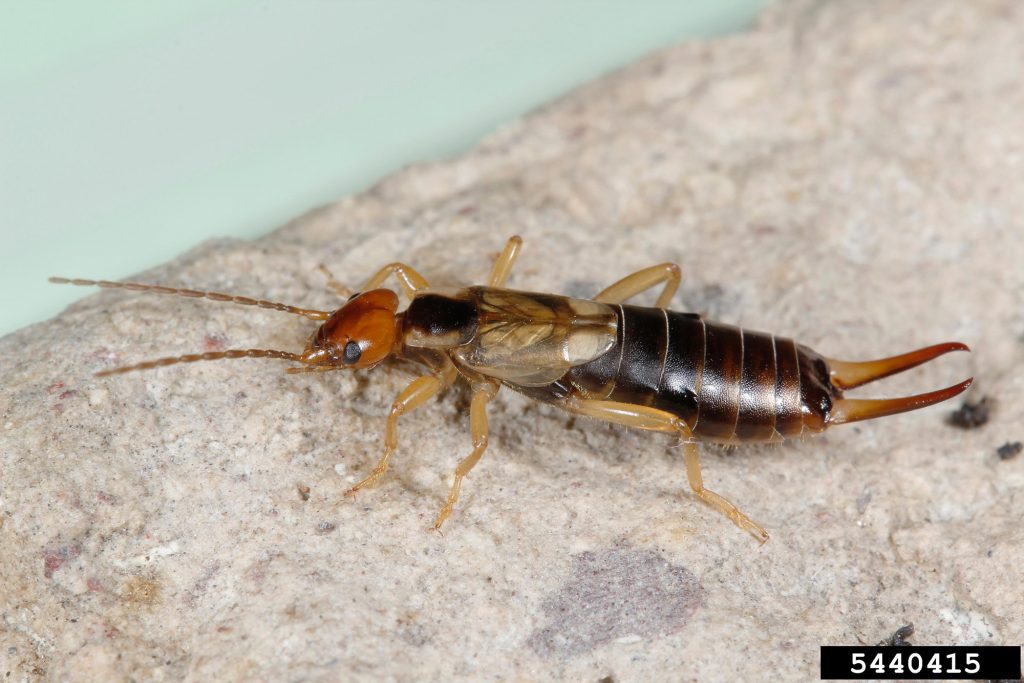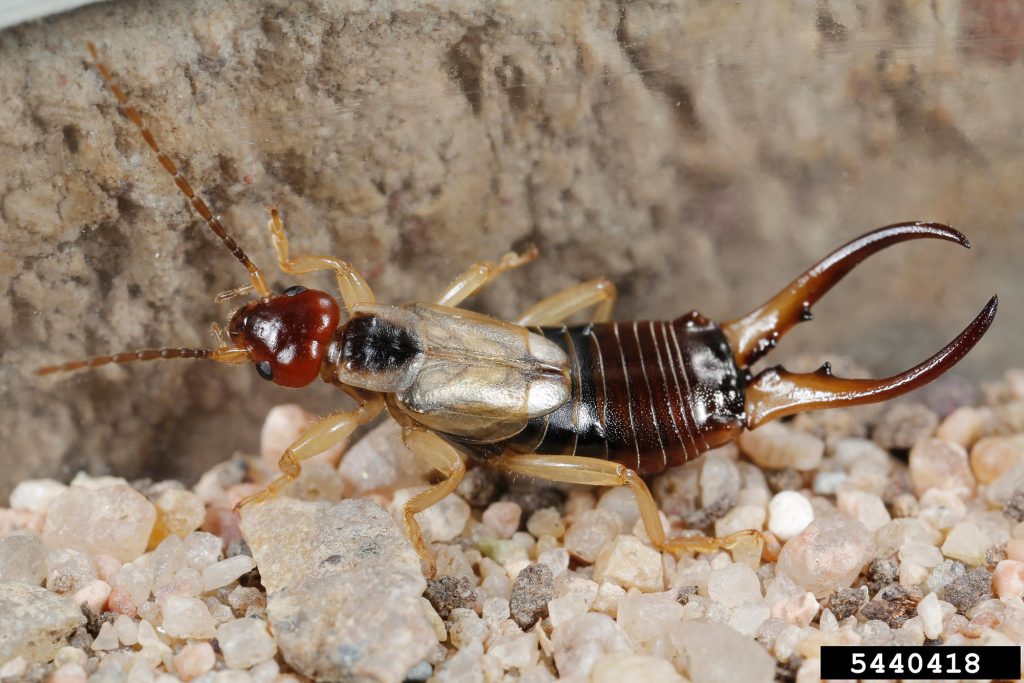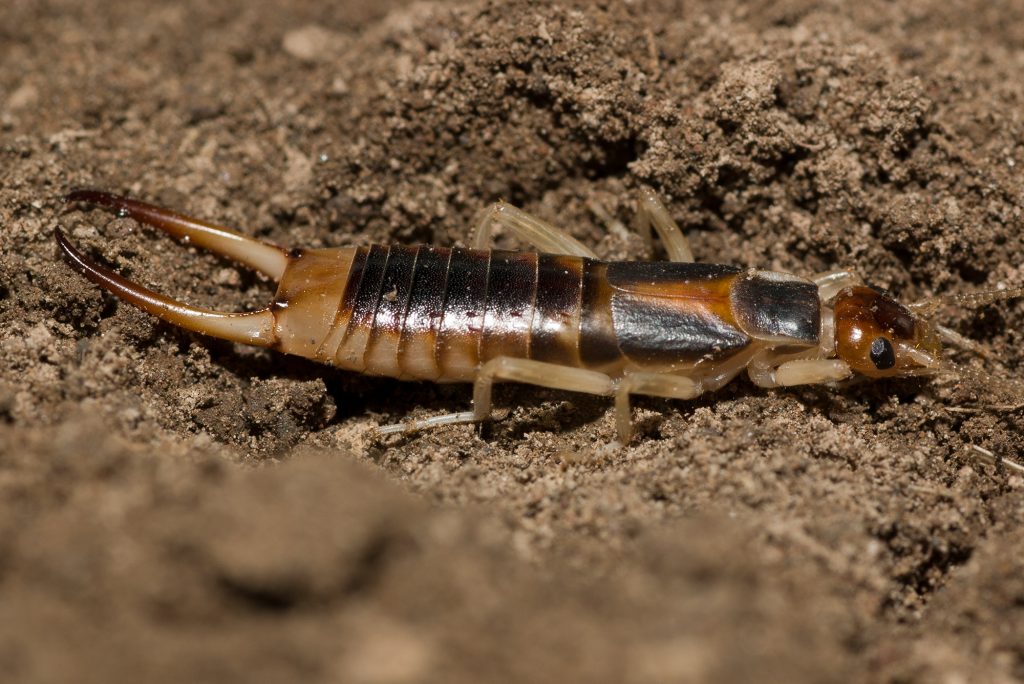European earwig
Forficula auricularia

Photo by Lisa Kirkland, Cesar Australia
Summary Top
The European earwig is an invasive species and is widespread throughout southern, south-eastern, and south-western regions of Australia. It has a very broad host range, eating a variety of broadacre and horticultural crops, as well as dead and living plant and animal material. Canola and some legume crops are particularly susceptible to damage. European earwig control options are limited in broadacre crops, especially chemical control. There are no known natural enemies which can effectively control the European earwig in Australia. Soil tillage may help suppress earwig numbers and disrupt breeding sites.
Occurrence Top
The European earwig is an invasive, temperate species in Australia; its native range includes Europe, West Asia and northern Africa.1
The European earwig was likely introduced to Australia prior to the 1900s and it is now widespread throughout areas of Victoria, Tasmania, South Australia, southern New South Wales, and south-western Western Australia.1,2
The current distribution of the European earwig in southern Australia is associated with human-influenced environments (e.g. cropping).2
No-till practices and stubble retention likely provide a more favourable environment for the European earwig. It is thought that the increased uptake of these practices is driving population growth on broadacre farms.
Description Top
Adult European earwigs are 12-24 mm long and are smooth, flat and elongated. They are mostly dark brown in colour with yellow-fawn shoulders, and legs.
European earwigs are winged (although they rarely fly) – they have one pair of short yellow-fawn hardened forewings and second pair of soft membranous hindwings which are not visible.
Like all earwigs, they have thin, segmented antennae, and a pair of pincers at the rear of their body. Males have longer curved pincers, whereas females have straight pincers.
Nymphs are similar to adults in appearance, except they are smaller, paler, and their wings are not fully developed.


Lifecycle Top
In Australian cropping environments, mating occurs during late summer and early autumn, and as temperatures decline from March to May, female earwigs appear to enter paddocks and disperse to create nests under soil clods, sometimes assisted by a male.
The main brood of eggs is laid (20 to 80 white oval eggs) from May, at which time the male (if present) is aggressively forced to leave the nest by the female (so that he doesn’t cannibalise the brood). A second brood of eggs may be laid after this, potentially as late as October. This brood is generally made up of much fewer eggs than the first.
The eggs hatch in ~4-6 weeks and nymphs go through four instars, each taking ~4-6 weeks. The first and second instars do not leave the nests until around August. Adult and nymphs peak around October/November depending on region and year. European earwig development is highly temperature dependant, and so the time to reach each instar will be shorter when exposed to warmer microclimates (i.e. soil temperature).3
As crops senesce and are harvested, the European earwig appears to move from paddocks to neighbouring landscapes with diverse vegetation. The following year, they re-enter paddocks during early autumn.

Behaviour Top
The European earwig is an omnivore and is extremely polyphagous, eating a range of both living and dead plant and animal material.4
While commonly regarded as a crop pest in Australia, overseas the European earwig is often considered a beneficial natural enemy of agricultural pests, such as aphids and caterpillars, particularly in fruit orchards and vineyards.5-7
The European earwig is a social insect, aggregating in clusters and nests.8 In paddocks, they are often patchily distributed and found under soil clods, rocks and debris.
As a nocturnal species, during the day adults and nymphs seek shelter in dark locations.
Adult females provide maternal care for their nymphs by providing food, shelter and protecting them against predators.9
The European earwig defends itself with its pincers and also by secreting a bad-smelling substance, which has microbial, nematocidal, and fungicidal properties.10
Similar to Top
The European earwig can be confused with other earwigs, including a beneficial native earwig, the common brown earwig (Labidura truncata).
The common brown earwig preys on soft-bodied insects including moth larvae and pupae in broadacre crops.11 It can be distinguished from European earwigs by the orange triangle present on its back, and its relatively non-gregarious behaviour.8

Crops attacked Top
The European earwig can attack a wide range of broadacre, horticultural and ornamental plants. Canola, lucerne and some legumes are some of the more susceptible broadacre crops; cereals and chickpeas are less susceptible but can still incur some feeding damage.
Damage Top
The European earwig feed on leaves and stems, and on germinating seed. In Australia, broadacre winter crops are most vulnerable to feeding damage during establishment.
Typically, feeding results in irregular shaped holes in leaves and/or shredded/jagged leaves, and damage first appears on the outer paddock edges.
In severe infestations, young plants can be defoliated or chewed down to ground level.
It is difficult to distinguish European earwig feeding damage from slug, snail, slater and millipede damage.
The European earwig can also contaminate grain at harvest, adding additional cleaning costs, particularly in windrowed crops.12

Monitor Top
Crops should be monitored for the presence of European earwigs before and after sowing.
Visual searches
As a nocturnal species, European earwigs are most likely to be seen at night with a torch. If searching during the day, check under soil clumps, stubble residue, rocks and wood.
Traps
Shelter traps such as carpet squares, tiles or cardboard rolls, create a favorable habitat, and can be used to lure and detect earwigs.
Pitfall traps can also be used to detect earwig movement and presence.
Economic thresholds Top
Economic thresholds have not been developed for the European earwig.
Management options Top
Biological
There are no known natural enemies which can effectively control the European earwig in Australia.
Vertebrates such as birds and lizards will feed on earwigs, and European earwigs are also cannibalistic, however this is unlikely to provide sufficient population reduction.
Cultural
Some studies show that soil tillage can reduce earwig numbers.5,13
As European earwigs typically construct their nests under soil clods and seek shelter during the day, tillage and farming practices which disturb soil and reduce stubble loads, may help to reduce breeding sites and suppress populations.
If there are particular paddocks where European earwigs are routinely problematic, growers may wish to try sowing a higher seeding rate or a high vigour variety to compensate for damage and/or earlier sowing to help plants establish rapidly and outgrow invertebrate damage.
Prevent introduction and spread of European earwigs by practicing good farm hygiene. European earwigs can be transported in contaminated seed, machinery and vehicles.
Chemical
Chemical options for control of European earwigs are very limited.
There are no registered chemical sprays in broadacre crops. Broadspectrum bare-earth and foliar insecticides applied to control other establishments may not impact European earwigs as they seek shelter during the day.
Canola seed is often bought by growers pre-coated with an insecticide seed dressing. Laboratory-based microcosm trials have demonstrated high European earwig death rates after they have fed on young canola grown from fipronil-treated seed. 14
Laboratory-based microcosm trials have shown that methiocarb baits, which are registered against slugs and snails in oilseeds, cereals and pastures, have efficacy against the European earwig (these trials were preliminary and methiocarb baits are not registered for protection against European earwig).15
Acknowledgements Top
This article was compiled by Julia Severi (cesar). Thanks to Dr Matthew Binns (CSIRO) and Thomas Heddle (SARDI) for their technical contributions and reviews.
References/Further Reading Top
1 Quarrell SR, Arabi J, Suwalski A, Veuille M, Wirth T, and Allen GR, The invasion biology of the invasive earwig, Forficula auricularia in Australasian ecosystems, Biol Invasions 20:1553–1565, Springer International Publishing (2018).
2 Hill MP, Binns M, Umina PA, Hoffmann AA, and Macfadyen S, Climate, human influence and the distribution limits of the invasive European earwig, Forficula auricularia, in Australia, Pest Manag Sci 75:134–143 (2019).
3 Moerkens R, Gobin B, Peusens G, Helsen H, Hilton R, Dib H, et al., Optimizing biocontrol using phenological day degree models: The European earwig in pipfruit orchards, Agric For Entomol 13:301–312 (2011).
4 Crumb SE, Eide PM, and Bonn AE, The European earwig, USDA Tech Bull 766:76 (1941).
5 Moerkens R, Leirs H, Peusens G, Beliën T, and Gobin B, Natural and human causes of earwig mortality during winter: Temperature, parasitoids and soil tillage, J Appl Entomol 136:490–500 (2012).
6 Frank SD, Wratten SD, Sandhu HS, and Shrewsbury PM, Video analysis to determine how habitat strata affects predator diversity and predation of Epiphyas postvittana (Lepidoptera: Tortricidae) in a vineyard. Biological Control 41: 230-236 (2007).
7 Wearing CH, Attfield BA, and Colhoun K (2010) Biological control of woolly apple aphid, Eriosoma lanigerum (Hausmann), during transition to integrated fruit production for pipfruit in Central Otago, New Zealand. New Zealand Journal of Crop and Horticultural Science 38: 255 – 273.
8 Sauphanor B and Sureau F, Aggregation behaviour and interspecific relationships in Dermaptera, Oecologia 96:360–364 (1993).
9 Lamb RJ, Parental behavior in the dermaptera with special reference Dermaptera showing parental behavior role of the male in nest establishment, Can Entomol:609–619 (1976).
10 Gasch T, Schott M, Wehrenfennig C, Düring RA, and Vilcinskas A, Multifunctional weaponry: The chemical defenses of earwigs, J Insect Physiol 59:1186–1193, Elsevier Ltd (2013).
11 Horne PA and Edward CL, Phenology and Food Preferences of Labidura truncata Kirby (Dermaptera: Labiduridae) in Western Victoria, J Aust Entomol Soc 34:101–104 (1995).
12 Grains Research and Development Corporation, Southern region: Earwigs in the medium and high rainfall zones. European Earwigs Factsheet (2013).
13 Sharley DJ, Hoffmann AA, and Thomson LJ, The effects of soil tillage on beneficial invertebrates within the vineyard, Agric For Entomol 10:233–243 (2008).
14 Umina P & Carson P (cesar), 2012, unpublished.
15 Clouston A, Bell N & Umina P (cesar), 2015, unpublished.
| Date | Version | Author(s) | Reviewed by |
|---|---|---|---|
| May 2019 | 2.0 | Julia Severi (cesar) | Matthew Binns (CSIRO), Thomas Heddle (SARDI) |
What are PestNotes?
PestNotes are information sheets developed through a collaboration between Cesar Australia and the South Australian Research and Development Institute (SARDI). Copyright: © All material published in PestNotes is copyright protected by Cesar Australia and SARDI and may not be reproduced in any form without written permission from both agencies.
Disclaimer
The material provided in PestNotes is based on the best available information at the time of publishing. No person should act on the basis of the contents of this publication without first obtaining independent, professional advice. PestNotes may identify products by proprietary or trade names to help readers identify particular products. We do not endorse or recommend the products of any manufacturer referred to. Other products may perform as well as or better than those specifically referred to. Cesar Australia and PIRSA will not be liable for any loss, damage, cost or expense incurred or arising by reason of any person using or relying on the information in this publication. Any research with unregistered pesticides or products referred to in PestNotes does not constitute a recommendation for that particular use.

